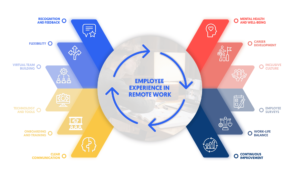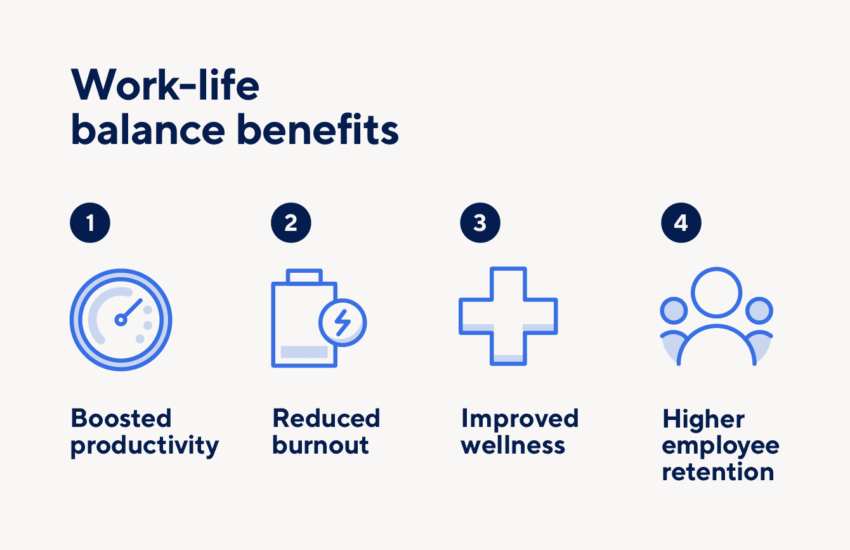The workplace has fundamentally shifted, with remote and hybrid work models becoming the norm rather than the exception. For organizations, this change is both an opportunity and a challenge, demanding that leaders rethink productivity, employee engagement, and talent development in the context of this evolving landscape. McKinsey reports that 58% of employees now have the option to work from home at least part of the time, and 35% can work remotely full-time. To remain competitive, organizations must strategically adapt to these preferences, implementing flexible policies, investing in digital tools, and prioritizing employee well-being to drive both performance and satisfaction.
Implementing Flexible Work Policies
Flexibility has become a major factor in employee satisfaction and retention. According to a 2024 study by Deloitte, 82% of employees who work remotely or in a hybrid model report higher job satisfaction and are less likely to consider leaving their organization. Flexibility in scheduling, choice of workspace, and adaptive management practices are now essential. Leaders who allow employees to tailor their work environment to individual needs experience lower turnover rates and higher engagement, contributing to both productivity and innovation.
Investing in Digital Collaboration Tools
Seamless communication and collaboration are critical to the success of remote and hybrid teams. Companies are now investing heavily in digital collaboration tools like Microsoft Teams, Slack, and Zoom to facilitate real-time communication. A report by Gartner found that organizations using advanced collaboration platforms saw a 25% increase in team productivity. Furthermore, adopting tools that integrate well with existing workflows minimizes disruptions and helps teams stay aligned on objectives. In Ireland, the government is training civil service workers in artificial intelligence to enhance service delivery, underscoring the importance of equipping employees with digital skills to support future workplace demands.
Balancing Productivity and Work-Life Integration
While productivity has increased for many organizations with the shift to remote work, work-life balance remains a challenge. A 2023 LinkedIn survey revealed that 60% of remote employees struggle to disconnect after hours, leading to burnout. Organizations that set clear boundaries and encourage employees to prioritize their well-being see higher levels of engagement and lower absenteeism. Leaders are encouraged to establish policies that respect personal time, such as “no meetings Fridays” or limiting after-hours communication, which have shown to improve mental health and reduce stress.

Prioritizing Employee Well-Being and Engagement
Well-being initiatives are critical in sustaining engagement and loyalty among remote and hybrid employees. A study by Gallup indicates that well-being programs contribute to a 21% increase in productivity and a 24% increase in job satisfaction. Companies like Google and Salesforce have introduced mental health resources and remote-friendly benefits, such as wellness stipends and flexible PTO, to support their workforce. By fostering a culture that values employee well-being, organizations can build loyalty, reduce turnover, and create a more resilient workforce.
Upskilling and Adapting to Evolving Job Roles
Remote and hybrid models have accelerated the need for digital skills, and upskilling is now essential. Companies that invest in digital training report a 15% higher productivity rate among remote employees (Accenture, 2023). The Irish government’s plan to upskill civil service workers in AI highlights the importance of preparing employees for emerging job functions, which is critical for maintaining competitive advantages. Organizations that actively upskill their workforce demonstrate a commitment to professional growth, helping employees remain relevant and engaged.
Creating Inclusive and Collaborative Hybrid Cultures
Maintaining a sense of belonging is crucial as work becomes increasingly decentralized. Hybrid models can unintentionally isolate remote employees or create disparities in visibility and advancement opportunities. Leaders who foster an inclusive culture, prioritizing equal access to resources and encouraging team-building activities, enhance collaboration and cohesion. Data from Harvard Business Review suggests that companies with strong hybrid cultures see a 22% increase in employee collaboration and a 17% boost in innovation, underscoring the importance of inclusive practices.
The shift to remote and hybrid work models is reshaping the future of work. Leaders who embrace flexibility, prioritize well-being, invest in collaboration tools, and focus on upskilling will be better positioned to attract and retain top talent. Balancing productivity with work-life integration and fostering a collaborative, inclusive culture are vital strategies to drive sustainable success in this new era. As organizations navigate these models, adaptability will be the key to thriving in a digitally connected and rapidly evolving work environment.







